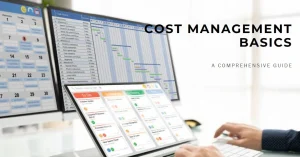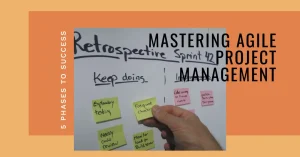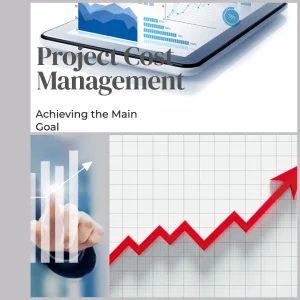I. Introduction
Hello, fellow project management enthusiasts! Today, we’re diving into the fascinating world of stakeholder management and its crucial role in ensuring the success of our projects. If you’ve ever been involved in a project, you know how complex and challenging it can be to juggle multiple tasks, deadlines, and priorities. But have you ever stopped to think about the people who hold the key to your project’s success? That’s right; we’re talking about stakeholders.
A. Briefly define project management and stakeholder management
Before we get started, let’s define our terms. Project management is the practice of initiating, planning, executing, monitoring, and closing projects to achieve specific goals and objectives within a defined scope, time, and budget. Stakeholder management, on the other hand, is a subset of project management that focuses on the identification, analysis, and engagement of individuals or groups who have an interest in, or can be affected by, the outcome of a project.
B. Explain the relationship between project management and stakeholder management
So, why are we talking about stakeholder management in the context of project management? Well, my friends, it’s because these two concepts are inextricably linked. Project success largely depends on the support and collaboration of stakeholders. When we effectively manage stakeholder relationships, we pave the way for smoother communication, better decision-making, and a more positive project environment.
C. Importance of stakeholder management in ensuring project success
Imagine this: you’re managing a project to develop a new app. You’ve gathered a talented team, and everyone is excited to get started. But, as the project progresses, you realize you’ve overlooked the concerns of key stakeholders, like the marketing department, end-users, and even the CEO. Suddenly, you’re faced with a barrage of questions, doubts, and unmet expectations. Sound familiar?
This is where stakeholder management comes in. By actively identifying, engaging, and managing stakeholder relationships, we can avoid misunderstandings, align expectations, and foster a sense of ownership among everyone involved. Ultimately, effective stakeholder management can make or break a project.
So, are you ready to explore the world of stakeholder management and learn how to wield its power for project success? Let’s dive in!
II. Identifying Stakeholders
A. Definition and types of stakeholders
Welcome back, project management aficionados! As we continue our journey into the realm of stakeholder management, our first stop is identifying who our stakeholders are. Simply put, stakeholders are individuals or groups who have an interest in, can be affected by, or can influence the outcome of a project. They come in all shapes and sizes, from internal team members to external clients, suppliers, and even the local community.
B. Importance of stakeholder identification
You might be wondering, “Why is it so important to identify stakeholders in the first place?” Well, my fellow project managers, the answer is simple: you can’t manage what you don’t know. By identifying your stakeholders early on, you can ensure that their needs, concerns, and expectations are taken into account throughout the project. This not only helps to avoid nasty surprises down the road but also paves the way for building strong relationships and fostering collaboration.
C. Methods to identify stakeholders
Now that we understand the importance of stakeholder identification, let’s talk about how to go about it. Here are some methods to help you uncover the hidden gems (a.k.a. stakeholders) in your project:
- Brainstorming: Gather your project team and start listing all the people or groups that come to mind when you think about your project. Don’t worry about being too thorough at this stage; the goal is to get the ideas flowing.
- Review project documentation: Go through your project charter, business case, or any other relevant documents to identify stakeholders who might have been mentioned or involved in the project’s inception.
- Consult organizational charts: Take a look at your organization’s structure to identify departments or individuals who may have a stake in your project.
- Seek advice from experienced colleagues: Tap into the wisdom of your peers or superiors who have been involved in similar projects before. They might be able to point you towards stakeholders you hadn’t considered.
- Use stakeholder analysis templates: There are numerous tools and templates available online that can help you systematically identify stakeholders. Explore these resources to make your stakeholder identification process more comprehensive.
Remember, identifying stakeholders is an ongoing process. As your project progresses, new stakeholders may emerge, while others might lose their relevance. Keep your eyes and ears open, and be prepared to update your stakeholder list as needed.
Stay tuned, as we’ll be diving into the exciting world of stakeholder analysis in the next section!
III. Stakeholder Analysis
A. Definition and objectives of stakeholder analysis
Hey there, project management trailblazers! Now that we’ve identified our stakeholders, it’s time to take a closer look at their needs, expectations, and potential impact on our projects. Enter the world of stakeholder analysis! This essential step in the stakeholder management process involves assessing the interests, influence, and power of each stakeholder so that we can effectively engage with them and make informed decisions.
B. Tools and techniques for stakeholder analysis
Ready to dive into stakeholder analysis? Here are some popular tools and techniques that can help you unravel the intricacies of your stakeholders’ positions:
- Power-interest grid: This simple yet effective tool involves plotting stakeholders on a grid based on their power (their ability to influence the project) and interest (their level of concern about the project). By categorizing stakeholders in this way, you can prioritize your engagement efforts and allocate resources accordingly.
- Stakeholder Salience Model: Going a step further, this model considers three attributes – power, legitimacy, and urgency – to assess the importance of stakeholders to a project. By evaluating stakeholders based on these factors, you can better understand their potential impact and plan your engagement strategies accordingly.
- SWOT analysis: Conduct a SWOT (Strengths, Weaknesses, Opportunities, Threats) analysis to evaluate the internal and external factors that might affect your stakeholders and, in turn, your project.
- Surveys and interviews: To truly understand your stakeholders, sometimes it’s best to go straight to the source. Conduct surveys, interviews, or focus groups to gather valuable insights into their needs, expectations, and concerns.
C. Assessing stakeholder interests and influence
As you dive into stakeholder analysis, remember that it’s not just about understanding who has the most power or who shouts the loudest. It’s also about recognizing the unique perspectives, strengths, and contributions that each stakeholder brings to the table.
Ask yourself questions like:
- What are the stakeholder’s key concerns or priorities?
- How might their interests align or conflict with the project’s objectives?
- What potential influence do they have on the project’s success or failure?
- How can you leverage their support or mitigate their objections?
By answering these questions, you’ll be better equipped to create tailored engagement strategies and foster strong, collaborative relationships with your stakeholders.
Stay tuned for the next section, where we’ll explore the art of stakeholder engagement and learn how to put our newfound stakeholder knowledge to good use!
IV. Stakeholder Engagement
A. Stakeholder engagement strategies
Greetings, project management gurus! Now that we’ve identified and analyzed our stakeholders, it’s time to bring them on board and keep them engaged throughout our project journey. Stakeholder engagement is all about fostering open communication, building trust, and creating a collaborative environment where everyone feels heard and valued.
Here are some tried-and-tested stakeholder engagement strategies to help you win over even the toughest of stakeholders:
- Develop a tailored communication plan: Remember, one size does not fit all when it comes to stakeholder communication. Design a communication plan that takes into account the unique needs, preferences, and influence levels of each stakeholder group.
- Be transparent and proactive: Keep your stakeholders informed about project progress, challenges, and decisions. By being open and proactive in your communication, you can build trust and demonstrate your commitment to addressing stakeholder concerns.
- Create opportunities for feedback: Encourage stakeholder input by creating regular touchpoints, such as meetings, workshops, or online forums, where stakeholders can voice their opinions and contribute to the project’s success.
- Empower stakeholders: Give your stakeholders a sense of ownership and involvement by involving them in decision-making processes and acknowledging their contributions.
B. Communication methods and frequency
When it comes to stakeholder communication, variety is the spice of life! Mix and match different communication methods to keep your stakeholders engaged and informed. Some popular options include:
- In-person meetings and presentations
- Virtual meetings and webinars
- Email updates and newsletters
- Online collaboration platforms
- Social media and intranet updates
Remember, the key to effective communication is striking the right balance between too little and too much information. Tailor the frequency of your updates to the needs and preferences of your stakeholders, keeping in mind that some stakeholders may require more frequent communication than others.
C. Resolving conflicts and managing expectations
Let’s face it, conflicts and disagreements are an inevitable part of any project. When it comes to stakeholder management, the key is to address conflicts head-on and find a way to balance competing interests and priorities.
Here are some tips for managing stakeholder expectations and resolving conflicts:
- Set clear expectations: From the get-go, be transparent about the project’s goals, scope, and limitations. This will help prevent misunderstandings and unmet expectations down the line.
- Be empathetic and listen actively: When conflicts arise, take the time to understand the underlying concerns and emotions of your stakeholders. By demonstrating empathy and actively listening, you can build trust and find a common ground for resolution.
- Develop a collaborative mindset: Foster a culture of collaboration and openness, where stakeholders feel comfortable sharing their concerns and working together to find solutions.
- Seek external support when needed: In some cases, you may need to enlist the help of external experts, such as mediators or consultants, to help resolve complex stakeholder conflicts.
Get ready for the next section, where we’ll delve into the realm of monitoring and controlling stakeholder relationships. See you there!
V. Monitoring and Controlling Stakeholder Relationships
A. Assessing stakeholder satisfaction
Hey there, project management champions! As we continue our stakeholder management journey, it’s crucial to remember that our work doesn’t end once we’ve engaged our stakeholders. Monitoring and controlling stakeholder relationships is an ongoing process that ensures we’re meeting their expectations and adapting to their evolving needs.
One way to gauge how well we’re doing in the stakeholder management department is by assessing stakeholder satisfaction. Regularly check in with your stakeholders to gather feedback on your communication, responsiveness, and overall project performance. You can do this through surveys, interviews, or informal conversations.
B. Adapting to changing stakeholder needs and expectations
In the dynamic world of project management, change is the only constant. Stakeholder needs and expectations can shift as the project progresses, and it’s our responsibility as project managers to stay on top of these changes and respond accordingly.
Here are some tips for adapting to changing stakeholder needs and expectations:
- Maintain open lines of communication: Encourage your stakeholders to share their concerns and ideas, and make it clear that their input is valued and appreciated.
- Be flexible and adaptable: When changes arise, be prepared to reassess your strategies and adjust your plans to accommodate new stakeholder requirements.
- Keep stakeholders informed: When changes affect the project’s scope, schedule, or budget, make sure your stakeholders are aware of the implications and understand the rationale behind the adjustments.
C. Evaluating and improving stakeholder management processes
Continuous improvement is the name of the game when it comes to stakeholder management. Regularly evaluate your stakeholder management processes to identify areas of strength and opportunities for growth.
Ask yourself questions like:
- Are we effectively identifying and analyzing our stakeholders?
- Is our communication plan meeting the needs of our stakeholders?
- Are we adequately addressing stakeholder concerns and resolving conflicts?
- How can we improve our stakeholder engagement strategies moving forward?
By reflecting on these questions and taking action to address any identified gaps, you can ensure your stakeholder management game remains strong and your projects continue to thrive.
Next up, we’ll explore a real-life case study that demonstrates the power of successful stakeholder management in action. Stay tuned!
VI. Case Study: Successful Stakeholder Management in a Project
A. Description of the project
Hello again, project management aficionados! To bring all our stakeholder management learnings to life, let’s dive into a real-life case study that showcases the power of effective stakeholder management in action.
Picture this: a mid-sized company decided to implement a new customer relationship management (CRM) system to streamline their sales and customer service processes. The project’s primary goals were to improve customer satisfaction, increase sales efficiency, and reduce response times.
B. Stakeholder management challenges faced
As with any project, the CRM implementation faced its fair share of stakeholder management challenges. Some key stakeholders included:
- Sales team members: Concerned about the learning curve associated with the new system and potential disruption to their workflows.
- Customer service representatives: Worried about the additional workload of migrating customer data and the need to learn a new system.
- Management: Focused on the potential return on investment (ROI) and ensuring the CRM would deliver the desired results.
C. Stakeholder management strategies implemented
To address these challenges, the project manager employed a range of stakeholder management strategies:
- Involving stakeholders in the decision-making process: The project manager ensured that representatives from the sales and customer service teams were included in key decisions, such as the selection of the CRM platform and the design of new processes.
- Providing tailored communication: The project manager developed a communication plan that addressed the unique needs and concerns of each stakeholder group. For example, they shared regular updates on the CRM’s anticipated ROI with management, while providing hands-on training and support for the sales and customer service teams.
- Establishing a feedback loop: The project manager created a feedback channel where stakeholders could voice their concerns and suggestions throughout the implementation process. This helped to build trust and maintain open lines of communication.
D. Impact on the overall project outcome
Thanks to the project manager’s proactive stakeholder management approach, the CRM implementation was a resounding success. The sales and customer service teams adapted quickly to the new system, and the company saw a significant improvement in customer satisfaction, sales efficiency, and response times. Furthermore, the project’s success served as a testament to the power of effective stakeholder management and its ability to drive positive project outcomes.
As we wrap up our exploration of stakeholder management, let’s recap our key takeaways and set our sights on future project success.
VII. Key Takeaways and Conclusion
A. Recapping the importance of stakeholder management
Well, folks, we’ve come a long way on our stakeholder management journey. As we wrap up, let’s take a moment to recap some of the most important lessons we’ve learned along the way:
- Stakeholder management is crucial to project success: By effectively managing stakeholder relationships, you can ensure that their needs, expectations, and concerns are addressed, paving the way for smoother project execution and better outcomes.
- Identify, analyze, engage, and monitor: The four pillars of stakeholder management – identifying stakeholders, analyzing their interests and influence, engaging with them effectively, and monitoring their satisfaction – are critical to building strong, collaborative relationships that drive project success.
- Adapt and improve: Stakeholder management is an ongoing process. Be prepared to adapt to changing stakeholder needs and expectations and continuously evaluate and improve your stakeholder management practices.
B. Conclusion and call to action
As project managers, our mission is to bring people together and create an environment where everyone’s strengths, perspectives, and contributions are valued. By mastering the art of stakeholder management, we can build the foundations for successful, long-lasting projects that not only achieve their goals but also foster collaboration and trust.
So, what are you waiting for? Go forth and conquer the world of stakeholder management, my fellow project management enthusiasts! And as you do, always remember that the key to project success lies in the relationships we build and nurture along the way.
If you found this blog post helpful, don’t forget to share it with your network and let us know your thoughts in the comments below. Until next time, happy project managing!
To find out how Artificial Intelligence is changing the Project Management landscape, you have enjoy reading this article https://www.shaunstoltz.com/did-artificial-intelligence-just-change-everything-about-project-management/
Find out more about Shaun Stoltz https://www.shaunstoltz.com/about/
This post was written by an AI and reviewed/edited by a human.



